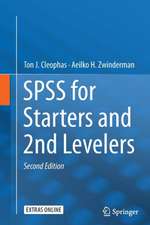Interpersonal Coordination: A Social Neuroscience Approach
Autor Nobuyuki Inuien Limba Engleză Paperback – 28 dec 2018
| Toate formatele și edițiile | Preț | Express |
|---|---|---|
| Paperback (1) | 975.89 lei 38-44 zile | |
| Springer Nature Singapore – 28 dec 2018 | 975.89 lei 38-44 zile | |
| Hardback (1) | 998.07 lei 38-44 zile | |
| Springer Nature Singapore – 24 sep 2018 | 998.07 lei 38-44 zile |
Preț: 975.89 lei
Preț vechi: 1027.26 lei
-5% Nou
Puncte Express: 1464
Preț estimativ în valută:
186.73€ • 194.98$ • 154.20£
186.73€ • 194.98$ • 154.20£
Carte tipărită la comandă
Livrare economică 11-17 aprilie
Preluare comenzi: 021 569.72.76
Specificații
ISBN-13: 9789811346798
ISBN-10: 9811346798
Pagini: 244
Ilustrații: XII, 244 p. 68 illus., 2 illus. in color.
Dimensiuni: 155 x 235 mm
Greutate: 0 kg
Ediția:Softcover reprint of the original 1st ed. 2018
Editura: Springer Nature Singapore
Colecția Springer
Locul publicării:Singapore, Singapore
ISBN-10: 9811346798
Pagini: 244
Ilustrații: XII, 244 p. 68 illus., 2 illus. in color.
Dimensiuni: 155 x 235 mm
Greutate: 0 kg
Ediția:Softcover reprint of the original 1st ed. 2018
Editura: Springer Nature Singapore
Colecția Springer
Locul publicării:Singapore, Singapore
Cuprins
1 Introduction.- References.- 2The background of the study on interpersonal coordination.- 2.1The social brain.- 2.2The motor cortex and its relation to social behavior.- 2.3 The social function of the mirror neuron system.- 2.4Imitation, mimicry, and its relation to social behavior.- 2.5Joint perception.- 2.6Observational motor learning.- 2.7The effect of action expertise on shared representation.- 2.8The effect of motor expertise on observational learning in sports.- 2.9The effect of shared representation on team sports.- 2.10 The effect of shared representation on musical ensemble performance.- References.- 3 An overview of the study on interpersonal coordination.- 3.1 Unintentional interpersonal entrainment.- 3.2 Intentional interpersonal coordination.- 3.3 Development of interpersonal coordination.- References.- 4 Complementary and synchronous force production in joint action.- 4.1 Two heads are better than one.- 4.2 Is there social loafing in joint action that consists of four people?.- 4.3 A leader-follower relationship in joint action.- 4.4 Effects of speech on joint action.- 4.5 Load perturbation facilitates interpersonal error compensation during joint action.- References.- 5 Is there bidirectional transfer between joint and solo actions?.- References.- 6 Motor control hierarchy in joint action that involves bimanual action.- References.- 7 Conclusion.- References.- Acknowledgement.
Notă biografică
Nobuyuki Inui, Ph.D.
Laboratory of Human Motor Control, Naruto University of Education, Japan
Textul de pe ultima copertă
This book explores the fascinating area of interpersonal coordination in force production tasks, outlining the author’s extensive research to date and presenting stimulating new perspectives. The purpose is to provide a detailed exposition of current understanding of the science behind interpersonal joint action. Readers will find clear explanation of concepts from social cognition and neuroscience that are key to an understanding of the field, including the social brain hypothesis, the mirror neuron system, and joint action, as well as other relevant background information. The author then proceeds to present an overview of recent original studies on interpersonal movement coordination performed at his laboratory in Japan. These studies provide insights into such issues as complementary and synchronous force production in joint action, bidirectional transfer between joint and solo actions, and motor control hierarchy in joint action involving bimanual force. They also set the direction for integration of knowledge of physical properties and social cognition. The book will be of interest for researchers and graduate students in all areas of the biomedical sciences.
Caracteristici
Examines current understanding of the science behind interpersonal joint action
Explains key relevant concepts from social cognition and neuroscience
Presents important original research and stimulating new perspectives
Sets the direction for integration of knowledge of physical properties and social cognition
Explains key relevant concepts from social cognition and neuroscience
Presents important original research and stimulating new perspectives
Sets the direction for integration of knowledge of physical properties and social cognition























